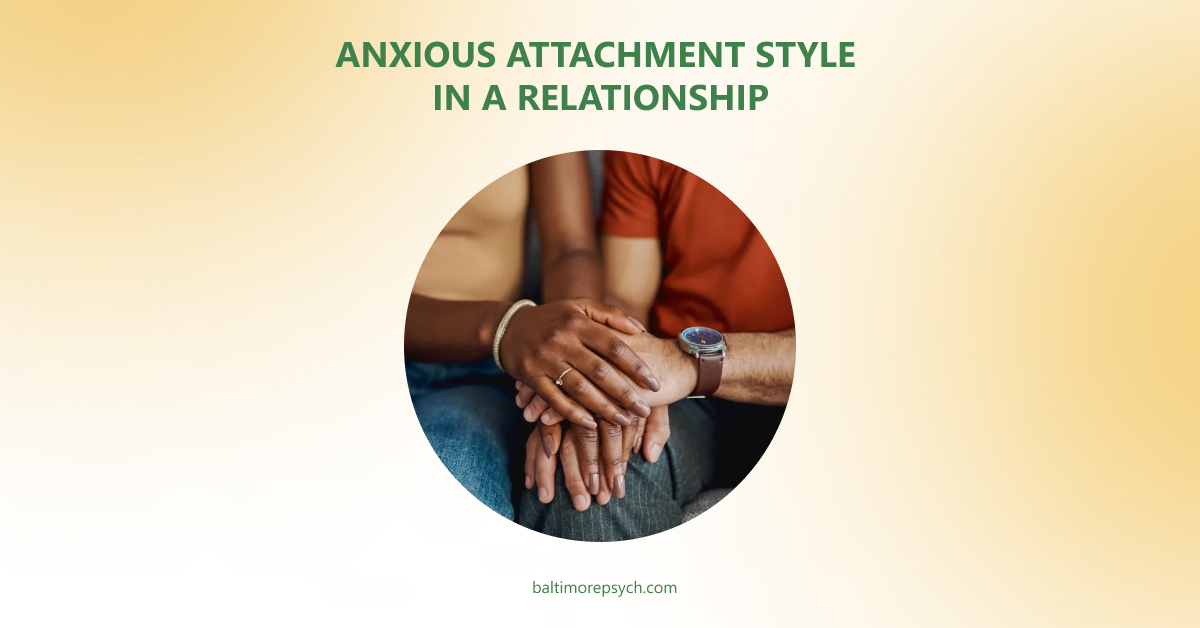In the realm of relationships, attachment styles dictate individuals’ emotional and behavioral responses, particularly in close and intimate connections. Among these styles, the anxious attachment style has gained notable attention as it presents a growing concern. Originating from early childhood experiences, this attachment style significantly influences how individuals perceive, interpret, and engage with their romantic partners or significant others.

Importance Of Understanding Attachment Styles In Psychological Well-Being
Understanding attachment styles is crucial for comprehending one’s psychological well-being and relationship dynamics. Different attachment styles in relationships influence how individuals form and maintain relationships, how they communicate their needs, and how they respond to emotional intimacy. By understanding their attachment style, individuals can gain insight into their patterns of relating and can work towards developing healthier and more fulfilling relationships.
Overview Of Anxious Attachment Style And Its Impact On Relationships
Anxious attachment style is one of the three primary attachment styles, alongside secure and avoidant styles. People with an anxious attachment style tend to crave closeness and reassurance from their partners, but they also experience heightened anxiety and fear of rejection or abandonment.
These individuals may exhibit clingy behavior, have difficulty trusting their partners, and often seek constant validation and approval. Anxious attachment styles can significantly impact relationship dynamics and can lead to emotional distress and relationship conflicts.
Science Behind Anxious Attachment Style In A Relationship
Recent research on anxious attachment style has provided valuable insights into its description and implications. One study conducted by Sue Johnson found that individuals with anxious attachment styles tend to have heightened sensitivity to social cues related to rejection or abandonment, leading to increased vigilance and anxiety in relationships. The study also revealed that anxious attachment was associated with difficulties in emotion regulation, resulting in more intense emotional reactions to relationship stressors.
Another study by Adam S. Smith (2022) explored the neurobiological underpinnings of anxious attachment and discovered that individuals with this attachment style exhibited altered activation patterns in brain regions associated with threat detection and emotional processing. These findings suggest that anxious attachment is not only a psychological phenomenon but also has neurobiological correlates.
These recent studies highlight the complexity of anxious attachment style and provide a foundation for further research and targeted interventions to help individuals with anxious attachment develop more secure and fulfilling relationships.
Understanding Anxious Attachment Styles
Anxious-preoccupied attachment style and anxious-ambivalent attachment style are two variations of anxious attachment styles that significantly impact individuals’ relationships and emotional well-being. Anxious-preoccupied individuals exhibit a strong need for closeness and reassurance, often displaying clingy behavior and a fear of rejection.
On the other hand, anxious-ambivalent individuals experience mixed feelings about their partners, alternating between intense love and anger or resentment. Both attachment styles are rooted in early childhood experiences and can result in relationship conflicts, emotional volatility, and difficulties in establishing trust. Understanding these attachment styles is crucial for fostering healthier and more secure relationships. Let’s discuss each of the attachment types separately.
Anxious-Preoccupied Attachment Style
Individuals with an anxious-preoccupied attachment style often have a constant need for closeness and reassurance from their partners. They may be overly dependent on their partners for their emotional well-being and may exhibit clingy behavior. These individuals tend to have low self-esteem and a fear of rejection, which can lead to frequent relationship conflicts and emotional ups and downs.
Impact On Relationships
The anxious-preoccupied attachment style can have a significant impact on relationships. The constant need for reassurance and attention can put a strain on the partner, leading to feelings of being overwhelmed or suffocated. The anxious-preoccupied individual may interpret minor cues or ambiguous situations as signs of rejection, triggering anxiety and relationship conflicts.
Healing And Overcoming Anxious-Preoccupied Attachment Style
Healing from an anxious-preoccupied attachment style involves developing self-confidence, building trust in oneself, and learning to manage anxiety. This process often requires self-reflection, therapy, and developing secure attachment experiences in relationships.
Anxious-Ambivalent Attachment Style
The anxious-ambivalent attachment style in adults is characterized by a desire for closeness but also a fear of rejection and abandonment. Individuals with this style often experience mixed feelings about their partners, oscillating between intense love and anger or resentment. They may struggle with self-worth and constantly seek validation and reassurance from their partners.
Impact On Relationships
The anxious-ambivalent attachment style can create a cycle of push-pull dynamics in relationships. The individual may vacillate between being overly clingy and demanding and then becoming distant or angry in response to perceived threats or rejections. This inconsistency can lead to relationship instability and emotional distress for both partners.
Strategies For Managing Anxious-Ambivalent Attachment Style In Adulthood
There are the main areas to work on:
- managing an anxious-ambivalent attachment style requires developing self-awareness
- identifying triggers and patterns
- learning healthy ways to communicate needs and emotions
Therapy can be beneficial in helping individuals explore their attachment history and develop more secure and adaptive ways of relating.
Anxious-Preoccupied Vs. Anxious-Ambivalent Attachment Styles
Similarities And Differences
The anxious-preoccupied and anxious-ambivalent attachment styles share some common characteristics, such as a strong desire for closeness and fear of rejection. However, the anxious-preoccupied style tends to manifest as clinginess and dependency, while the anxious-ambivalent style involves ambivalence, mixed emotions, and a push-pull dynamic.
Common Challenges And Patterns In Relationships
Both styles can lead to relationship challenges, such as frequent conflicts, emotional highs and lows, and difficulties with trust and emotional stability. These attachment styles often attract partners with avoidant attachment styles, leading to a dynamic characterized by pursuit and distancing.
Anxious Vs. Avoidant Attachment Styles
Anxious and avoidant attachment styles often create a challenging relationship dynamic known as the anxious-avoidant trap. Individuals suffering from anxiety crave closeness and reassurance, while avoidant individuals tend to value independence and distance. This dynamic can result in a cycle of pursuing and distancing behaviors, exacerbating anxiety and creating instability in the relationship.
Signs and symptoms of attachment issues in adults
Attachment issues in adults can manifest in various ways, including fear of intimacy, difficulty trusting others, emotional volatility, and a tendency to attract unhealthy or unavailable partners. These individuals may also struggle with setting boundaries, expressing needs, and maintaining healthy relationship dynamics.
Understanding The Root Causes Of Attachment Issues
Attachment issues often stem from early childhood experiences, such as neglect, inconsistent caregiving, or traumatic events. These experiences shape an individual’s beliefs about themselves and relationships, leading to the development of insecure attachment styles.
Seeking Professional Help For Addressing Attachment Issues
Addressing attachment issues may require professional help. Mental health professionals, such as psychologists or therapists specializing in attachment and relationship issues, can provide support, guidance, and evidence-based interventions to help individuals work through their attachment-related challenges.
Coping Strategies For Individuals With Anxious Attachment
Self-Reflection And Self-Awareness Techniques
Self-reflection and self-awareness are essential for individuals with anxious attachments to recognize their patterns, triggers, and emotional reactions. Techniques like journaling, mindfulness, and therapy can facilitate self-reflection and help individuals gain insight into their attachment style and its impact on their relationships.
Setting Healthy Boundaries And Managing Expectations
Setting and maintaining healthy boundaries is crucial for individuals with anxious attachment. This involves understanding one’s needs and limits, communicating them assertively, and respecting the boundaries of others. Managing expectations involves cultivating realistic expectations and not relying solely on others for validation and happiness.
Cultivating Self-Esteem And Self-Reliance
Developing self-esteem and self-reliance is vital for individuals with anxious attachment styles. Engaging in activities that promote personal growth, seeking support from friends and loved ones, and practicing self-care can enhance self-esteem and foster a sense of self-reliance and independence.
Q&A
Q: How to deal with two anxious attachment styles in a relationship from both sides?
A: Dealing with two anxious attachment styles in a relationship can be challenging, but it’s important to focus on open communication, empathy, and mutual support. Both partners can work on developing self-awareness of their attachment patterns and triggers. Seeking couples therapy or relationship counseling can provide a structured and supportive environment for exploring and addressing attachment-related issues. Research by S. Johnson emphasizes the effectiveness of Emotionally Focused Therapy (EFT) in helping couples with anxious attachment styles build secure and healthier relationships.
Q: Why do I have attachment issues?
A: Attachment issues can stem from various factors, including early childhood experiences, such as inconsistent caregiving or trauma, which can shape one’s attachment style. Additionally, genetics, temperament, and environmental factors can also contribute to the development of attachment issues. Research by Fraley (2019) highlights the interplay between genetics and early experiences in the formation of attachment styles.
Q: Why do I get attached to people so easily?
A: Getting attached to people easily can be influenced by a combination of factors, including innate temperament, unmet emotional needs, and early attachment experiences. Individuals with anxious attachment styles often have a heightened need for closeness and fear of abandonment, which can contribute to forming attachments quickly. Research by Eastwick (2021) suggests that some people may be more prone to rapid attachment formation due to their attachment system’s sensitivity and responsiveness.
Q: Why do I need constant reassurance in my relationship?
A: Needing constant reassurance in a relationship is often associated with anxious attachment. This attachment style is characterized by a fear of rejection and a strong desire for validation and closeness. Research by Feeney and Noller (2011) highlights how individuals with anxious attachments seek reassurance as a way to alleviate anxiety and feel secure in their relationships.
Q: What causes anxiety in childhood?
A: Anxiety in childhood can have multiple causes, including genetic predispositions, family environment, parenting styles, traumatic experiences, or high levels of stress. In the context of attachment, inconsistent or neglectful caregiving, parental conflicts, or early separation can contribute to the development of anxiety. A study by Erica M. Webster (2022) highlights the impact of adverse childhood experiences, such as maltreatment or parental psychopathology, on the development of anxiety disorders in childhood.
Please note that while these brief answers provide an overview, individual experiences and circumstances may vary, and it is important to consult with a mental health professional for a comprehensive understanding and personalized guidance.
Conclusion
Throughout this article, we have explored the concept of attachment styles, with a specific focus on anxious attachment styles. We have discussed the characteristics, origins, and impacts of anxious attachment styles on relationships. We also compared different types of anxious attachment styles and their challenges. Furthermore, we examined the interaction between anxious and avoidant attachment styles and strategies for developing a secure attachment.
Developing a secure attachment style is an ongoing journey that requires self-reflection, self-compassion, and a willingness to seek support when needed. Healing from an anxious attachment style can lead to more fulfilling relationships and improved overall well-being.

